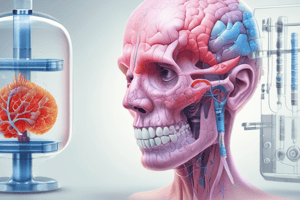Podcast
Questions and Answers
What is the definition of point-of-care testing (POCT)?
What is the definition of point-of-care testing (POCT)?
- Medical testing done by specialized pathologists
- Medical testing performed at the site of patient care (correct)
- Medical testing conducted in dedicated spaces
- Medical testing carried out in clinical laboratories
When was POCT first reported?
When was POCT first reported?
- 1550 A.D.
- 500 A.D.
- 500 B.C.
- 1550 B.C. (correct)
What is the key characteristic of POCT according to the College of American Pathologists?
What is the key characteristic of POCT according to the College of American Pathologists?
- Performed inside clinical laboratories
- Done outside clinical facilities (correct)
- Requires permanent dedicated space
- Performed only by clinical laboratory technicians
How did Egyptian physicians in 1550 B.C. use ants in the context of medical testing?
How did Egyptian physicians in 1550 B.C. use ants in the context of medical testing?
Which term best describes POCT based on the information provided?
Which term best describes POCT based on the information provided?
Which criteria are included in the ASSURED criteria for rapid tests by WHO?
Which criteria are included in the ASSURED criteria for rapid tests by WHO?
What is a key advantage of POCT devices over traditional methods?
What is a key advantage of POCT devices over traditional methods?
How do POCT devices contribute to minimizing burden at a central level?
How do POCT devices contribute to minimizing burden at a central level?
In the context of patient care, what does the term 'decentralized testing' refer to?
In the context of patient care, what does the term 'decentralized testing' refer to?
What is the primary goal of using ASSURED criteria for rapid tests?
What is the primary goal of using ASSURED criteria for rapid tests?
How do POCT devices aid in enhancing efficiency of patient care?
How do POCT devices aid in enhancing efficiency of patient care?
What is a key advantage of point-of-care testing (POCT) when it comes to patient care?
What is a key advantage of point-of-care testing (POCT) when it comes to patient care?
What is a logistical challenge associated with getting all staff to perform POCT consistently?
What is a logistical challenge associated with getting all staff to perform POCT consistently?
What type of sensors are commonly used in point-of-care testing (POCT) instruments?
What type of sensors are commonly used in point-of-care testing (POCT) instruments?
Which of the following is an ideal requirement for a POCT device?
Which of the following is an ideal requirement for a POCT device?
What distinguishes complex strip devices from dipsticks in point-of-care testing?
What distinguishes complex strip devices from dipsticks in point-of-care testing?
What is the primary function of immunosensors in point-of-care testing (POCT) devices?
What is the primary function of immunosensors in point-of-care testing (POCT) devices?
Flashcards
Point-of-Care Testing (POCT)
Point-of-Care Testing (POCT)
Medical testing performed close to the patient, near the site of care.
Near patient testing
Near patient testing
Another name for Point-of-Care Testing (POCT).
ASSURED criteria
ASSURED criteria
WHO criteria for rapid POCT tests, emphasizing affordability, sensitivity, specificity, user-friendliness, robustness, rapidity, and deliverability.
Affordable (POCT)
Affordable (POCT)
Signup and view all the flashcards
Rapid results (POCT)
Rapid results (POCT)
Signup and view all the flashcards
Reduced turn-around time
Reduced turn-around time
Signup and view all the flashcards
Improved patient morbidity/mortality
Improved patient morbidity/mortality
Signup and view all the flashcards
Portable instruments
Portable instruments
Signup and view all the flashcards
Finger sticks
Finger sticks
Signup and view all the flashcards
Blood gas analysis
Blood gas analysis
Signup and view all the flashcards
Electrolytes
Electrolytes
Signup and view all the flashcards
Pregnancy test
Pregnancy test
Signup and view all the flashcards
Cardiac tests
Cardiac tests
Signup and view all the flashcards
Infectious disease testing
Infectious disease testing
Signup and view all the flashcards
Single-use devices
Single-use devices
Signup and view all the flashcards
Dipsticks
Dipsticks
Signup and view all the flashcards
Biosensors
Biosensors
Signup and view all the flashcards
Immunosensors
Immunosensors
Signup and view all the flashcards
Quality control
Quality control
Signup and view all the flashcards
Calibration
Calibration
Signup and view all the flashcards
Analytical specifications
Analytical specifications
Signup and view all the flashcards
Laboratory professionals
Laboratory professionals
Signup and view all the flashcards
Consumable reagents
Consumable reagents
Signup and view all the flashcards
Study Notes
Point-of-Care Testing (POCT)
- Defined as medical testing at or near the site of patient care
- According to College of American Pathologists (CAP), POCT is “diagnostic tests designed to be used at or near the site where the patient is located, that do not require permanent dedicated space, and that are performed outside the physical facilities of the clinical laboratories”
- First reported in papyrus documents in 1550 B.C. by Egyptian physicians using ants to determine glycosuria in patients suspected of having diabetes mellitus
Characteristics of POCT
- Also known as near patient testing, bedside testing, ancillary testing, alternative testing, and decentralized testing
- Widely used ASSURED criteria for rapid tests by WHO:
- Affordable
- Sensitive
- Specific
- User-friendly
- Robust and rapid (results available in less than 30 minutes)
- Equipment-free
- Deliverable to those who need the test
Benefits of POCT
- Improve quality of patient care
- Enhance efficiency of patient care
- Increase physician and patient satisfaction
- Improve patient education
- Decrease liability risk
- Minimize burden at central level
POCT Devices
- Use small amounts of unprocessed specimens
- Use finger sticks over phlebotomy
- Types of tests:
- Blood gas
- Electrolytes
- Pregnancy
- Cardiac
- Infectious disease testing
- Portable, enhancing the possibility of “bringing lab to the patient”
- Current estimates: POCT encompasses nearly one-third of in vitro diagnostic testing
Advantages of POCT
- Reduced turn-around time
- Improved patient morbidity and mortality
- Reduction in hospital admission
- Improved interaction between patient and carer
- Reduction in clinical visits
- Improved cost of care
- Reduction in administrative work associated with test requesting and reporting
Staff Requirements
- Anyone can perform POCT with proper training and documentation of competency
- Laboratory professionals can assist in POCT programs
Ideal Requirements for POCT Devices
- First result in a minute or less
- Portable instruments with consumable reagents cartridges
- Single-operating protocol
- Capability of direct specimen analysis (whole blood, CSF, urine) / non-processed sample
- Simple operating procedure
- Flexible test menus
- Results that meet analytical specifications that are “fit-for-purpose” and with accuracy and precision comparable to central lab
- Built-in/integrated calibration and quality control
- Ambient temperature storage for reagents
- Low instrument cost
- Built-in regulatory record keeping
- Results provided as hard copy, stored, and available for transmission
Components of POCT Devices
- Bar code identification systems
- Sample delivery devices
- Reaction cell sensors
- Control and communications systems
- Data management and storage
- Manufacturing requirements
Sensor Technologies Used in POCT Instruments
- Optical or electrical signal chemosensors
- Biosensors
Types of POCT Devices
- Single-use qualitative strip or cartridge and/or strip devices
- Dipsticks (single-pad devices)
- Complex strips (complex pad with several layers, semi-permeable membrane)
- Immunosensors (biological sensors with recognition agent an antibody that binds to an analyte)
- Lateral flow immunoassay for troponin T
- Single-use quantitative cartridge and strip test
Studying That Suits You
Use AI to generate personalized quizzes and flashcards to suit your learning preferences.




